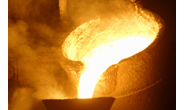International Steel Mills

Algoma loss widens; updates on BF, coke-making repairs
Written by Ethan Bernard
February 7, 2024
Algoma Steel
| Fiscal third quarter ended Dec. 31 | 2023 | 2022 | % change |
|---|---|---|---|
| Revenue | $615.4 | $567.8 | 8% |
| Net earnings (loss) | ($84.8) | ($69.8) | -21% |
| Per diluted share | ($0.78) | ($0.64) | -22% |
| Nine months ended Dec. 31 | |||
| Revenue | $2,175.2 | $2,101.1 | 4% |
| Net earnings (loss) | $77.2 | $318.9 | -76% |
| Per diluted share | $0.60 | $1.66 | -64% |
Algoma Steel reported a wider loss in its fiscal third quarter amid lingering impacts from the United Auto Workers (UAW) strike and “heavy seasonal maintenance.” Additionally, the Canadian steelmaker said it has completed repairs at it blast furnace and “restored partial coke-making capabilities” after a previously reported incident on Jan. 20.
Fiscal Q3’24 earnings
Sault Ste. Marie-based Algoma posted a net loss of 84.8 million Canadian dollars (USD$63 million) in its fiscal Q3’24 ended Dec. 31 vs. a loss of CA$69.8 million a year earlier on revenue that increased 8% to CA$615.4 million ($456.8 million).
For the increased revenue, the company cited “increased steel shipment volumes as a result of improved market conditions.”
Steel shipments for quarter totaled 516,068 short tons (st), up 12.6% from 458,341 st a year earlier.
“We delivered results in the fiscal third quarter that were consistent with our previously disclosed outlook, accomplished against a challenging backdrop that included the remaining impact of the UAW strike and a heavy seasonal maintenance quarter,” Algoma CEO Michael Garcia said in a statement on Tuesday.
Resuming operations after earlier incident
Garcia gave an update on the incident at Algoma’s coke batteries and BF. As previously reported, a structure supporting utilities piping at its coke-making plant collapsed on Jan. 20.
“Limited coke-making operations continue,” he said. “As we develop our revised production plan, we will continue to evaluate our requirement for purchased coke to supplement our current inventories.”
For safety reasons, BF operations were stopped when the incident occurred. There were some problems associated with the resart. Garcia noted that Algoma has finished all necessary repairs and has begun gradually restarting the BF, “increasing energy input as conditions permit.”
“Based on our current assessment, we anticipate producing usable hot metal within the next seven days,” he said. A return to full production is expected within the next two weeks.
“The outage at the blast furnace and limited coke production are collectively expected to negatively impact shipments, costs, and profitability in the fourth fiscal quarter,” he added.
Algoma said it has “standard insurance coverage” intended to cover these types of circumstances, including business interruption insurance. “The company is in the process of submitting claims under its insurance policies for covered losses,” it said.
In an earnings conference call on Wednesday, CFO Rajat Marwah said insurance advisers and adjusters were on site to assess the damage, and more updates would be provided in the next few months as they come in.
“All told, we expect the incident to impact production and shipments for more than three weeks, totaling roughly 120,000 tons to 150,000 tons,” Marwah said.
Garcia said on the call that Algoma anticipated repair costs in the CA$20-30-million range to be completed around April. A complete recovery of the coke batteries is expected.
Regarding long-term costs, Marwah said, “It’s too early to say.” He commented that after an initial survey of the coke batteries’ walls, “we don’t expect much degradation there, which is the key from long-term cost perspective.”
“We’ll probably be running at 30% to 40% of our production and using external coke during this quarter,” Marwah said. “And come next quarter we should get down to our full production levels.”
EAF update
Algoma said it has made substantial progress on the construction of two new EAFs to replace its existing BF and basic oxygen steelmaking operations. Garcia said the project remains “on time and on budget,” with commissioning expected late in calendar 2024.
The cumulative investment as of Dec. 31, was CA$509.9 million of the total projected cost of CA$825-875 million.
“Project commitments to date total approximately (CA)$750 million, with ~7% tied to time and material contracts, while the balance is fixed price in nature,” Algoma said.
After the switch to EAF steelmaking, Algoma’s facility is expected to reach an annual raw steel production capacity of ~3.7 million tons, matching its downstream finishing capacity, and to generate a ~70% reduction in annual carbon emissions.
In 2025, the company plans to operate in a “hybrid mode,” using both the BF and EAFs, before eventually phasing out the BF.
“That’s been the plan for some time as well as we think it makes the right financial sense,” Garcia said. “Obviously, financially we’ll continue to keep a very close eye on that,” he added, noting that would include evaluating the state of the assets after the current incident.
Marwah said the costs in hybrid mode running both the BF and EAFs will be higher initially, “as we are transitioning.” However, he noted when Algoma “starts shutting down the facilities and reducing the fixed costs, the costs will start coming down.”
Outlook
Talking about steel pricing in 2024 so far, Garcia said, although “off from year-end highs, these prices still represent a meaningful improvement from levels seen during much of 2023.”
Marwah said Algoma expects higher EBITDA in the current quarter due to aniticipated higher steel prices and increased volumes.
Garcia concluded by saying the company’s short-term strategic path is clear.
“We believe that EAF brings a tremendous strategic value to Algoma. We’re laser focused on executing that we’re on-time, on-budget. And we very much look forward to beginning commissioning at the end of this year,” he said.

Ethan Bernard
Read more from Ethan BernardLatest in International Steel Mills

Global steel mill output steady through May
Global raw steel production rose 2% from April to May, slightly above average production levels seen in recent months, according to data recently released by the World Steel Association (worldsteel).

Trump says US government to control 51% share in USS
President Trump says the US government will hold a 51% stake in U.S. Steel after the Nippon deal.

USS, Nippon Steel quiet as litigation deadline approaches
There has been little word from U.S. Steel, Nippon Steel, or the White House since President Trump endorsed the companies’ “partnership” on social media and celebrated it at the May 30 rally outside Pittsburgh.

Ternium’s Vedoya named AIST’s Steelmaker of the Year
Maximo Vedoya was awarded in recognition of Ternium’s expansion project in Pesquería, Mexico, and Ternium’s efforts to decarbonize steelmaking.

CRU: Baosteel hints at output cuts in China
Baosteel exec comments on market rumors of 50 million tons of output being cut this year, less than 0.5% of the 1 billion tons-plus China has produced annually in recent years.
